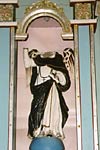
Manila, Thursday, 27 July 2006 03:15:07
Most tourists to the island of Bohol normally go for its natural and aquatic attractions. Snorkelling, diving, and hiking are the must-dos, while the Chocolate Hills, dolphins, whales, corals, and tarsiers are the must-sees. However, Bohol is also fertile ground for the equally rewarding and no less strenuous sport of heritage-hunting. In this adventure, the quarry might be a bit easier to track down but are just as endangered. Species range in size from the petite urnas to gigantic cathedrals, and in age from Baclayon church, one of the oldest in the country, to the freshly-weaved buri and bamboo baskets of Antequera.
Making your way around the province, one can embark on a fascinating journey through the evolution of Philippine art, architecture, construction and design. The wealth of prospective prey can be bewildering. Fortunately, the NCCA has published two very important field guides for the budding heritage hunter. There is Visita Iglesia, Regalado Trota Jose's painstakingly comprehensive guide to Bohol's churches, and Tubod, the Heart of Bohol, a book embracing the entirety of Bohol's cultural legacy. We also managed to ask Instituto Cervantes director, Dr. Javier Galvan, an architect by profession and ardent heritage conservationist, to lend some enlightening post-hunt commentary.
 |
| Panglao Watchtower |
Journeying onward, past the previously featured Cloribel house, just before we cross the causeway to Tagbilaran, is the town of Dauis. Its church is one of the fanciest and most Gothic in the province, the project of an ambitious Recollect parish priest who also had the adjacent bridge constructed. In contrast to the suggestively Oriental Panglao tower, the tower of Dauis has a cantilevered roof with wooden trusses more evocative of buildings in Medieval Europe. "They are on the same island, very close but they are very different," notes Dr. Galvan.
At Dauis is also where we first encountered the alarming impact of every heritage hunter's nemeses, the dastardly architectural salvagers, and their crooked comrades the relic thieves. The church was closed to the public as protection against these nefarious elements. Unfazed, we were still able to sneak into the back and catch a glimpse of the guarded treasures. Dr. Galvan grieves for the many santos and artistic artifacts that have been removed or stolen. "You can find more santos in the antique stores of Malate than in the churches. It's understandable how they need to close them because it's an unavoidable necessity in these modern times to keep the antiques and relics out of reach from people who may steal them. But it's a pity because the church is something that belongs to a community."
 |
| Vandalized Statue |
 |
| Dauis Church |
What has happened is that recently in many old structures they have built modern canopies or concrete awnings that seriously hamper the view of the facade at the very least, and completely ruin the original architecture at the very worst.
"In the beginning, the buildings were made by artisans who knew how to cut the stone. But these construction skills have been lost by society. With the arrival of concrete and steel, there came a particular moment in the 20th century when there was a divorce. All these skilled people, carpenters, fandejos, and guilders, were lost," mourns Dr. Galvan. "The alterations are normally done in very bad taste because they are made by people who are not professional. They don't have the sensitivity, the feel for how architecture was before. So the results in most cases are terrible."
But Dr. Galvan does not rule out renovation work altogether. "I agree that it is necessary because a building in use is a living organism. You cannot freeze it and put it in a box. But restoration is a discipline, you need trained and skilled people. Not just anyone can do it. You can't hire a contractor who only knows how to work with concrete and has never even heard about lime mortar which is fundamental for this work. You cannot put concrete on old stones, the pressure will destroy them. It is necessary to stop these people before they try to do any renovation work."
 |
| Clarin Ancestral House |
"There are many cases where there are people who have destroyed structures because they have thought that it is old and they want something new. You destroy a monument, something that has lasted centuries, to construct a new building without any character, absolutely similar to any building anywhere with no connection to Filipino history. That is a pity," Dr. Galvan sighs.
And yet Bohol has fared better than most regions in the Philippines. Neglected in favor of more populous and popular provinces for decades, Bohol's natural and cultural resources have managed to escape the blight brought by industrialization. The grandeur of their surviving heritage structures is where the humble Boholanos have an edge over their haughtier neighbors. "In Tagbilaran, the Presidencia is one of the very few civil buildings standing from the Spanish period, and that's quite outstanding," agrees Dr. Galvan. "There is awareness. The community has a sense of heritage, of the value of old things. Also, Bohol has a comprehensive inventory of its monuments, which other provinces lack. So the role Bohol might play for illustrative purposes, as a model for other provinces, is very important."
 |
| Bryde's whale |
(Published in the Manila Bulletin in May 2004. Also appeared on the SkyscraperCity Forum on 6 February 2006. This forum has numerous articles on Philippine Architecture; republished here with permission from the author. Pictures added by Jeroen Hellingman.)
Jude Defensor